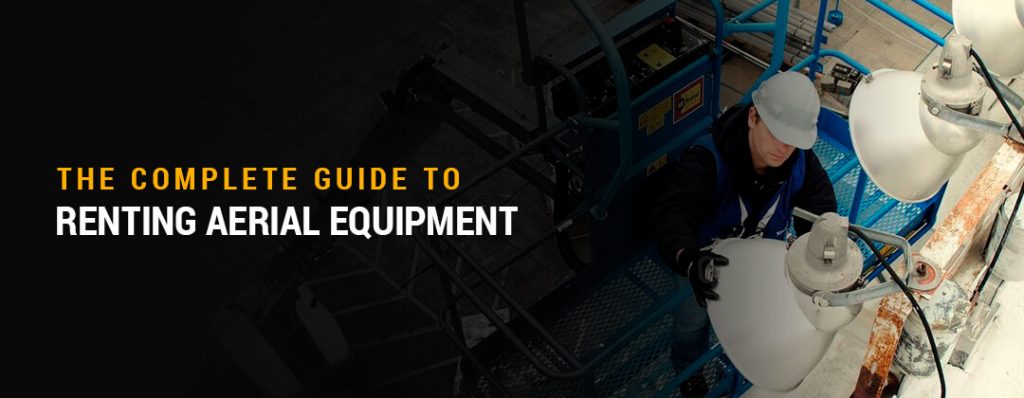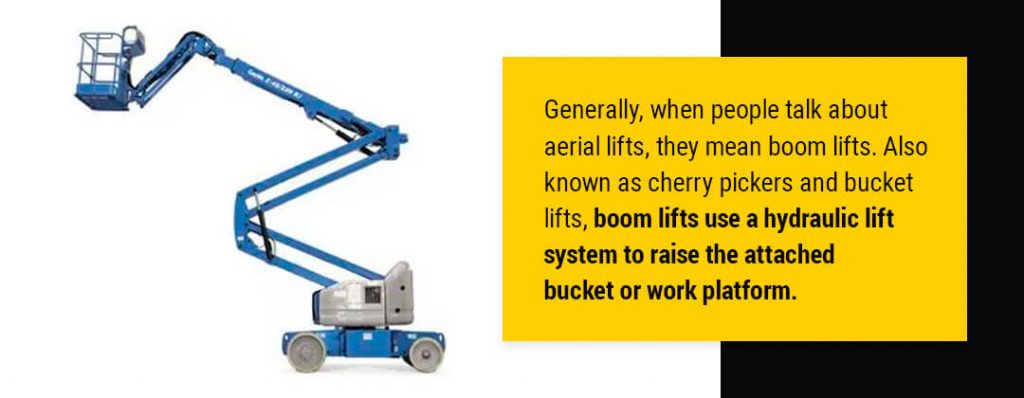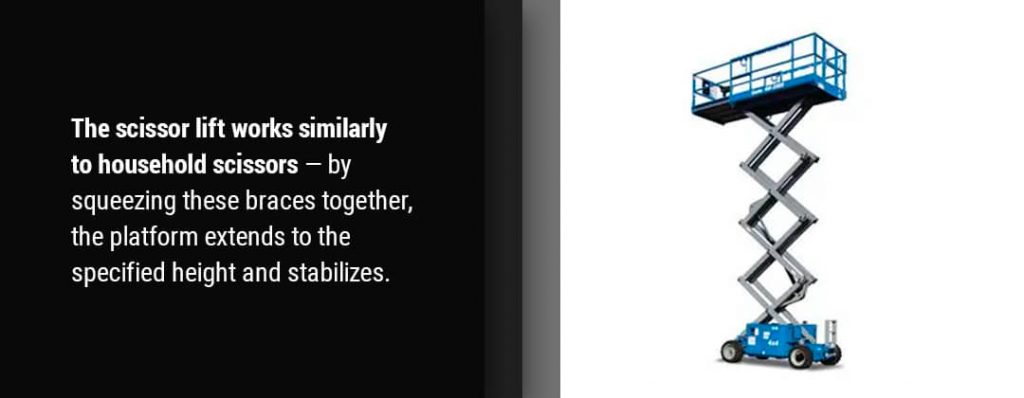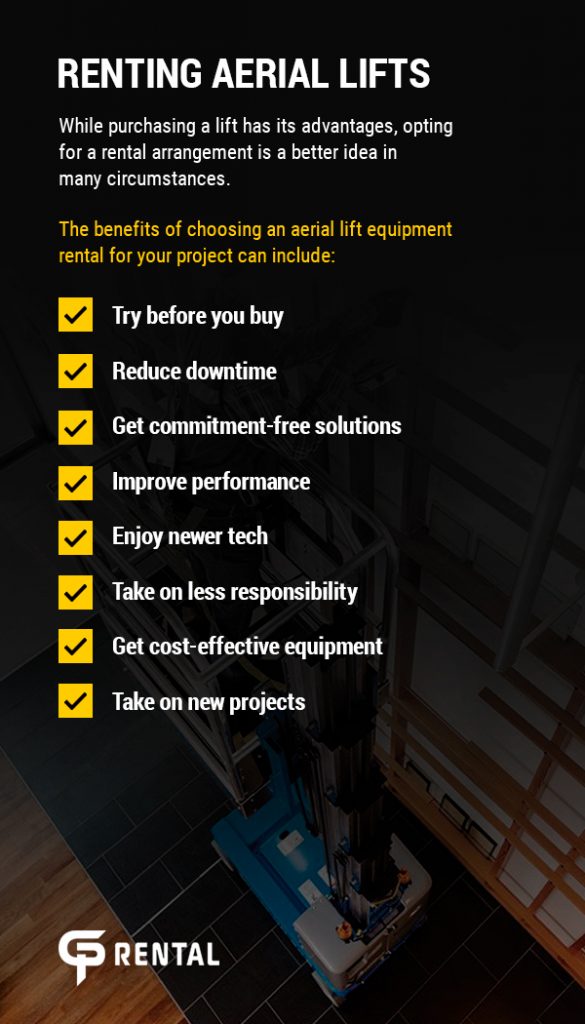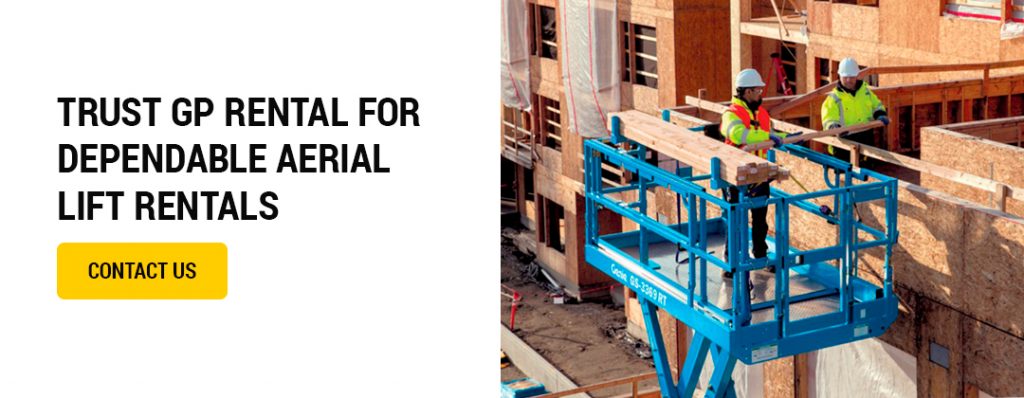The Complete Guide to Renting Aerial Equipment
Aerial lifts are versatile pieces of equipment that allow you to reach high work areas, like roofs, windows, treetops, ceilings and HVAC equipment. By providing a stable aerial platform, a lift offers the power and support your workers need to get the job done safely and efficiently.
This guide will explain the different types of aerial lifts, including common applications for each type. We’ll also discuss how to choose the right lift for your job site and the benefits of renting aerial lifts.
Aerial Lift Categories
Different types of lifts serve different purposes. From reaching extreme heights to providing a safe work surface in challenging terrain, the type of lift you need will depend heavily on your application and your job site’s unique conditions.
There are three primary categories of aerial lifts:
- Boom lifts
- Scissor lifts
- Vertical lifts
Each type also has several subtypes, each of which is suitable for more specialized applications.
What Are Boom Lifts?
Generally, when people talk about aerial lifts, they mean boom lifts. Also known as cherry pickers and bucket lifts, boom lifts use a hydraulic lift system to raise the attached bucket or work platform.
There are two basic types of aerial lifts:
- Telescopic boom lifts: Telescopic booms have straight arms, which enables them to reach especially high areas. The arm extends and retracts in one direction like a telescope. Some models have a jib extension that allows a degree of flexibility, but these lifts generally provide little horizontal maneuverability.
- Articulating boom lifts: Commonly called knuckle booms, articulating lifts have several joints along their arms that provide extra flexibility. As a result, articulating boom lifts can move over and around obstacles, allowing access to work areas even in crowded or hard-to-reach spaces. Jib extensions provide an additional few feet in any direction.
There are also specialized subtypes of boom lifts designed for specific applications, including:
- Towable boom lifts: The most portable boom lift, towable lifts are excellent for companies who switch between projects or need to cover multiple projects simultaneously. Typical use cases include outdoor decorating, utility line work, window washing and tree trimming. Fire departments also utilize towable lifts as replacements for conventional extension ladders.
- Atrium lifts: Atrium lifts are good for applications at extreme heights. Most of the time, their booms are articulated, so they’re highly maneuverable. Some can even rotate a full 360 degrees. Atrium lifts are common in wildlife inspection and construction applications.
What Are Scissor Lifts?
Scissor lifts consist of a large, flat work platform set atop a system of interlocked braces. The lift works similarly to household scissors — by squeezing these braces together, the platform extends to the specified height and stabilizes.
Generally, scissor lifts can handle more weight than other lifts. Some models can handle up to six adults and their equipment. However, they also tend to be less maneuverable, with little capability for moving around obstacles.
Scissor lift subtypes include:
- Electric scissor lifts: These battery-powered lifts boast high weight capacity and impressive maneuverability. They’re used mostly in indoor settings and on small-scale jobs, such as maintenance and window washing, but you may find specialized models on more intensive construction sites.
- Rough terrain scissor lifts: You’ll need a rough scissor lift when you’re on tough ground. These lifts come with extra supports and safety features like outriggers, fall arrest systems, four-wheel drive and positive traction control to ensure a stable work platform under even the harshest conditions. They often use diesel or liquid propane, making them generally unsuitable for indoor work sites.
What Are Vertical Lifts?
Also called man lifts, push arounds, personnel lifts or vertical mast lifts, vertical lifts are the smallest aerial lifts available. They tend to be lighter and more compact than scissor and boom lifts, making them ideal for getting through doors and other narrow pathways.
True to their name, vertical lifts extend straight up. Their maximum extended heights are usually lower than those of scissor or boom lifts, so consider your job requirements carefully.
Vertical lifts usually hold one person at a time due to their small size and narrow platforms, but some larger models can hold two or three people. Any job that requires more than that would benefit more from another type of lift.
Due to their light frame, vertical lifts are more practical for indoor work — wind or other environmental factors can impact the lift’s stability.
Typical uses for vertical lifts include:
- Warehousing
- Indoor construction work
- Building renovations and maintenance
- Overhead electrical work
How to Choose the Right Lift for Your Job
While each aerial lift can serve multiple purposes, some are better suited for certain applications than others. When you’re deciding which type of lift to rent, account for the following factors.
Height
Choosing a lift that can comfortably reach your work area is one of the most important considerations to make when deciding on a machine. There are two different measurements to pay attention to:
- Platform height: This is the vertical distance from the ground underneath your lift’s wheels to the bottom of the platform.
- Working height: The working height is typically six feet higher than the platform height. This measurement comes from adding the height of the worker standing on the platform to the platform height.
Mistaking these two measurements can leave you with a lift that is either too tall or too short for your job site. Additionally, a lift’s height may appear as a range or a single maximum value in a lift’s specifications, so keep dimensions in mind.
You should also consider any overhead obstacles that may make extending a lift difficult or unsafe. For example, if your project involves painting a hard-to-reach crevice of a ceiling, you’d be better off using an atrium lift with an articulated boom than a comparable straight telescopic boom lift that can only extend in one direction.
Capacity
Certain types of aerial lifts have higher weight capacities than others. For example, if you need more than two or three workers on the platform at a time, a scissor or boom lift will serve you much better than any vertical lift.
While you’re evaluating different lifts, make a list of the weights of every worker and tool that will be on the platform. In some cases, an estimate will suffice, but accurate numbers are always ideal.
Pay close attention to the specifications — some lifts will have a personnel limit regardless of weight. Even if you’re well under the maximum weight, you still need to comply with the personnel limit to ensure employee safety.
If you’ve decided on a lift but the personnel limit may be a limiting factor for you, rearranging the work schedule might be a good idea. Instead of completing multiple tasks at once, break the work up so only the specified number of workers will be on the platform at once.
Terrain
Accounting for your work environment is critical when choosing an aerial lift. Correctly matching your lift to your application ensures you will have the support and power you need to complete your work.
Important terrain factors include:
- General environment: The lift you need will change depending on whether you will be working indoors or outdoors. If your project is outside, you should also consider typical weather conditions in your area.
- Ground: The ground you’ll operate the lift on will determine the tires and supports you will need. Will you be working on dry, wet or frozen ground? Or will you be on finished floors? Rough terrain scissor lifts can accommodate sloped terrain and move efficiently over materials like gravel and dirt.
- Obstacles: Will you need to navigate the lift over ground-level obstacles? For example, if you’re working near an excavation site where debris is likely, you’ll want a lift with higher ground clearance so it can easily navigate to the work area.
Power
The type of power source your lift uses directly impacts your efficiency, which affects your bottom line. Some power sources are better suited for certain applications.
You’ll find the following fuel sources in aerial lifts:
- Liquid propane (LP): LP is easy to transport and store, making it an ideal fuel source for short periods of outdoor work.
- Diesel: Diesel often provides the most power, making it necessary for the largest and most rugged lifts.
- Battery: Battery-powered lifts are quiet and clean electric lifts. Note that you will need time to recharge the lift’s battery. Having additional batteries on-site or accounting for charging downtime in advance is crucial for ensuring optimal usage.
- Hybrid: Hybrid lifts provide the most flexibility. You can use them indoors with battery power and switch to diesel or propane for increased power when you move outside. This ability to switch between power sources allows you to reduce downtime while charging or refueling.
The space you’ll be working in is also an important determinant in what power source you should choose. For example, diesel lifts are better suited for outdoor applications because they emit toxic fumes. While battery-powered lifts are safe for indoor use, you’ll have to ensure an outlet or additional batteries are available to ensure continuous power.
Features and Accessories
The features you need will depend on your specific application. Common aerial lift features include:
- Outriggers: Many rough terrain lifts come with outriggers — thin legs that extend from the lift to provide extra support. These lifts are sometimes called spider lifts.
- Tires or tracks: The tires you need will depend on your application. If you’re working indoors, you’ll want a lift with non-marking tires. Wide flotation tires are best for sandy and soggy environments. Heavy-duty tires provide a lift with increased traction and maneuverability on uneven ground. More intense environments might require a lift with a crawler undercarriage and track system.
- Additional safety mechanisms: You’ll often find extra safety features on rough terrain lifts. For example, fall restraints and arrestors are common on rough terrain lifts because factors like extreme weather can pose a risk to workers at heights.
You may also want to look into additional accessories to enable greater efficiency while on the job. Some examples of attachments include:
- Boom lift tool trays
- Control box covers
- Battery chargers
- Drip diapers
- Joystick controllers
- Glazing Kits
Insurance
Understanding your insurance responsibility is important when renting any piece of heavy equipment, including aerial lifts. Carefully read and review your entire rental agreement before you sign.
Typically, a rental dealer will cover the equipment, but your company can be held accountable for any operator injuries or property damage that happens while the equipment is in use. This arrangement can vary depending on the provider you choose to work with.
Bottom line — make sure you know where the dealer’s coverage ends and your insurance obligation begins.
Operator Experience
To operate an aerial lift, you need someone who is familiar with best practices for aerial equipment safety. Even if someone on your team knows the basics, it’s best to choose an operator who can ensure your team follows all safety measures and enforces the lift’s maximum capacity.
If you still need someone to fill that role, your dealer may offer operator training, or they may be able to point you toward places you could go to find qualified operators.
Renting Aerial Lifts
While purchasing a lift has its advantages, opting for a rental arrangement is a better idea in many circumstances. The benefits of choosing an aerial lift equipment rental for your project can include:
- Try before you buy: If you’re already considering adding an aerial lift to your fleet, renting different models and testing them out is a great way to determine which type best suits your company.
- Reduce downtime: Unexpected breakdowns can result in long periods of downtime. A fast equipment rental can provide a temporary replacement while your machine undergoes repairs.
- Get commitment-free solutions: By renting an aerial lift, you can complete your project without having to commit to long-term costs like storage and transportation.
- Improve performance: Renting an aerial lift allows you to match lifts to specific projects. Once you finish one project, you can easily return the lift and rent another that better fits your next project.
- Enjoy newer tech: When you rent, you often gain access to newer models with more high-tech features at a cost-effective price.
- Take on less responsibility: Renting equipment means you usually don’t have to pay for repairs and maintenance. While best practices dictate keeping the equipment in good shape, the dealership is ultimately responsible for all major fixes and upgrades.
- Get cost-effective equipment: Renting is a cost-effective alternative to purchasing equipment, especially when you only need it for a short period of time.
- Take on new projects: Renting heavy equipment allows you to take on projects and tasks that may previously have been impossible. You’ll be able to expand your business — and you can return your lift whenever you’re done with it.
Trust GP Rental for Dependable Aerial Lift Rentals
At GP Rental, we’re proud to be your main lift rental in the eastern North Carolina region. We keep our low-hour rental equipment well-maintained, so it’s always ready to perform at peak capacity. We offer a variety of Genie aerial lifts, including scissor, vertical, articulating and straight boom models.
Browse our online selection of rental lifts to see what we have available, or find your nearest location here.
Still have questions? We’re here to help. Contact us for more information today.


